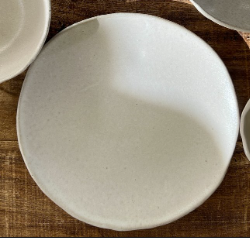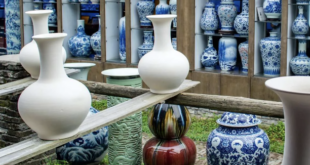Today, we dove into plate-making, which is slightly trickier than making bowls. The process starts off the same: begin by centering your clay on the wheel and then opening it up. However, unlike bowls, plates require a much wider base. After opening up the clay, you use your hands to press down and outward, gradually flattening the base while keeping the edges thinner. One of the most important things is to maintain even pressure to avoid warping, since plates are more prone to losing their shape due to the larger surface area.
When it comes to removing the plate from the wheel, it’s much more delicate compared to a bowl. With bowls, you can usually slice them off easily using the cutting wire, but for plates, there’s an extra step. First, you need to pour some water onto the wheel and let the cutting wire carry that water into the base of the plate as you slice it off. The water helps reduce friction and makes it easier to cut the clay without damaging the wide, flat bottom.
Lifting the plate off the wheel requires extra care too. Unlike a bowl, which has a more stable structure, plates are flat and fragile, so they can easily warp when picked up. You have to gently slide it onto a small tray for support. This extra caution is key to keeping your plate in shape until it dries and hardens enough to handle.
In the afternoon, the teacher also gave us a clever trick for fixing plates (or any piece) that don’t come out perfectly symmetrical. After using the torch to dry the surface until it’s just firm enough to handle, but still flexible, you can gently press and mold it into the shape you want. You can even leave behind your fingerprints as a personal touch to make the piece uniquely yours.
At noon, teachers and students in the studio gathered for a shared meal. Each person got a bowl of rice, and there were at least 20 dishes for everyone to enjoy. The local Jiangxi flavors are rich in chilies, and at one point, one of the women joked after fishing through a dish, “I thought this was just stir-fried red peppers with green peppers — didn’t expect there to be actual food under all these chilies!”
For dinner, we headed to a popular local restaurant called Huijia Ganfan (回家赣饭). The name immediately grabbed my attention, and here’s why: In China, the phrase Ganfan (干饭) is slang for “eating a hearty meal.” Now, here’s where it gets clever (and a bit of a dad joke): the character “Gan” (干) in Ganfan sounds exactly like the character for Jiangxi, “Gan” (赣), which is a nickname for the province. So, they swapped the character, and boom! The name now means “Going home for Jiangxi food” instead of just “Going home to eat.” It’s such a fun twist that made me chuckle.
Pro Tip: Bring a Cushion! For anyone planning to come to Jingdezhen to learn pottery or spend all day throwing clay, I have one important piece of advice: buy a seat cushion! After sitting on small, hard stools for two days in a row, your rear will be so sore that even sleeping becomes uncomfortable. Trust me, the cushion is a lifesaver!
 Tempus Magazine By Students, For Students
Tempus Magazine By Students, For Students 



